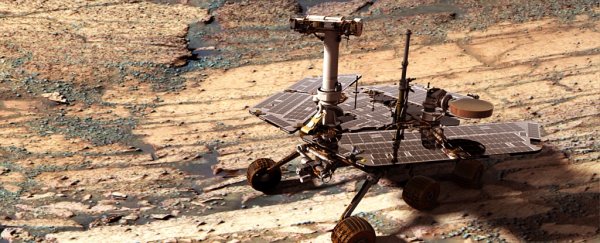NASA has suspended science operations on its brave little Mars rover, Opportunity, as a huge dust storm rages over its location in the planet's Perseverance Valley.
First detected by NASA on June 1, the storm has worsened over the weekend, the intense dust darkening the sky over Mars and leaving Opportunity in the dark.
And this is a problem - unlike Curiosity, which launched later with a nuclear generator, Opportunity relies on solar panels for power, and batteries for storage. So anything that inhibits the Sun's rays from reaching the rover is going to cause problems.
As of June 8, the storm spanned an area greater than 18 million square kilometres (7 million square miles), larger than the North American continent.
It's not the first major dust storm Opportunity has had to weather. In 2007, an enormous dust storm - much larger by area - caused the rover to enter minimal operations mode for a fortnight, including a few days of no communications in order to conserve power.
Bu this current storm is much, much stronger.
As of June 10, the storm had nearly doubled the level of atmospheric opacity, or darkness, experienced by the rover in 2007, measured in tau.
The 2007 storm reached a maximum of 5.5 tau. The new storm has hit 10.8 tau.
NASA noticed a significant drop in the rover's power levels on June 6, and has entered crisis mode. This is because Mars is really cold, and Opportunity relies on power from its solar panels to keep its battery warm.
This is a highly energy-intensive process, so as much stored power as possible needs to be reserved for warming. It's critical to the rover's survival - NASA believes its rover Spirit failed after it could not harvest enough sunlight to power its survival heaters.
NASA's instrumentation shows that the rover's current temperature is around -29 degrees Celsius (-20 degrees Fahrenheit). It's minimum operating temperature is -40 degrees Celsius (-40 degrees Fahrenheit). However, here the storm could actually help - the dust that blocks out the Sun's rays also absorbs heat, which raises the ambient temperature around the rover.
And there's another sign of hope for Opportunity. NASA has reported that, on Sunday June 10, they received a transmission from the rover, which means it still had enough power to communicate.
The storm could last weeks or months to come, and NASA is going to continue carefully monitoring the situation.
Opportunity, however, has had a brilliant run. Originally, its mission was only supposed to last 90 days. It's now been puttering away up there for 14 years.
